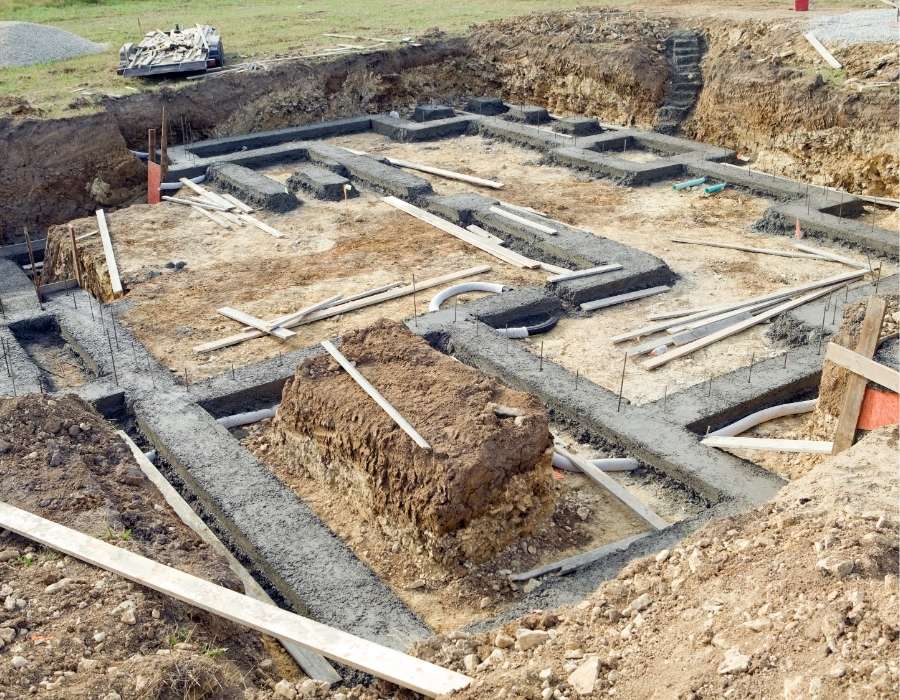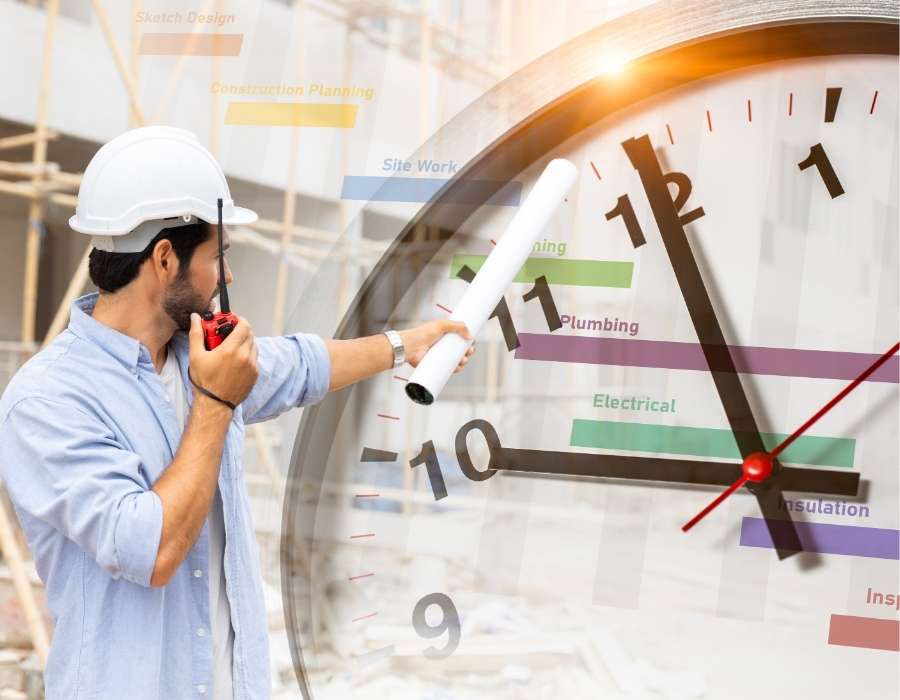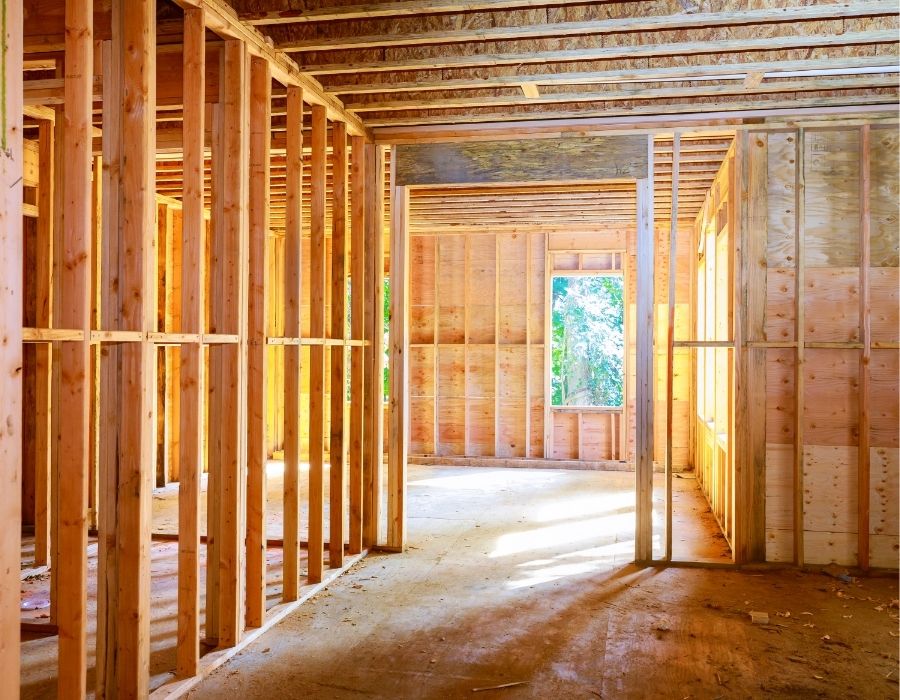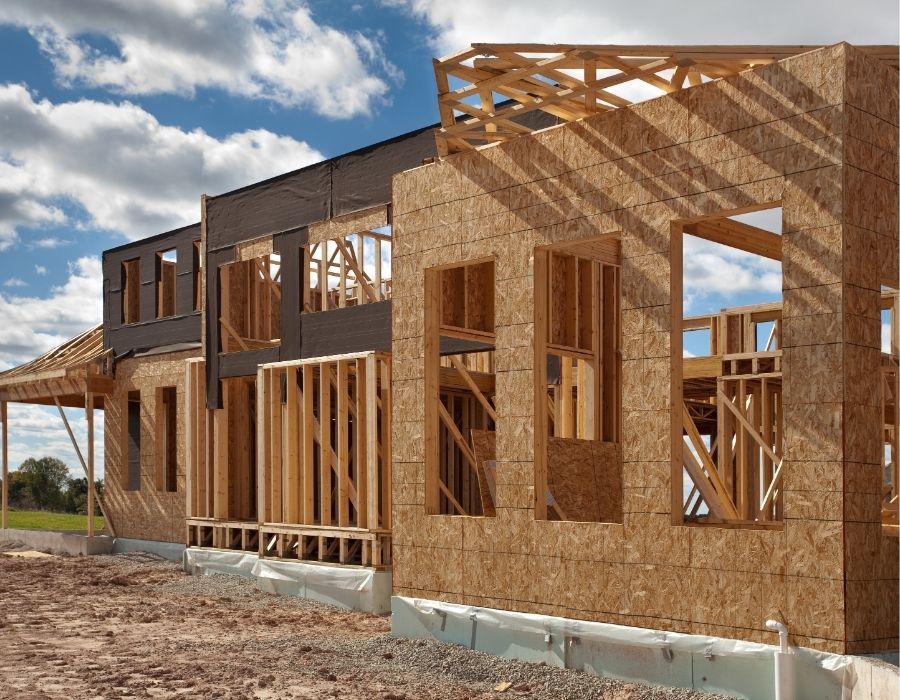The Major Construction Phases in Building a Custom Home
Building your custom home starts with pre-construction preparations, including securing permits and preparing the site. Afterwards, you’ll move to foundation construction, followed by structural framing. Once the foundation and framework are secure, mechanical rough-ins like electrical, plumbing, and heating systems are installed. Then, you can look forward to the interior finishing phase where walls are painted and fixtures are added. Throughout the project, quality control measures are taken and potential challenges are addressed, informed by your involvement. You’ll manage your custom home’s aesthetic and functionality decisions, budget, and project progress. As you explore further, more aspects of this exciting process are revealed.
Pre-Construction Preparations
Before the first shovel hits the dirt, pre-construction preparations set the foundation for your custom home. The first task, permit acquisition, is vital. Getting the necessary documentation from local authorities guarantees your project is legal and up to code. It’s a process that can be time-consuming but is absolutely essential.
Next comes site preparation. This involves clearing the land of any obstructions, including trees, rocks, or old structures. Site preparation also includes grading the land to ensure proper drainage. This phase sets the stage for the next step: plan development.
During plan development, you’ll finalize your custom home’s design and layout with your architect and builder. You’ll discuss everything from room sizes to the locations of doors and windows. It’s important to get these details right, as they’ll guide the rest of the construction process.
Once the plans are finalized, the excavation process begins. This is where your home starts to take physical form, with the digging of the foundation. Along with this, waterproofing techniques are used to protect the foundation from water damage, setting the stage for the next phase of construction: laying the foundation.
Laying the Foundation
With the pre-construction phase behind you, it’s time to lay the foundation, an integral step in your custom home construction. The foundation provides stability, making it essential to get this phase right.
The first step is the excavation process. Your site will transform from a patch of land into a plotted layout for your dream home.
- Excavation process: The crew digs the ground to the right depth, making sure the soil is stable enough to support your home.
- Concrete pouring: With the hole ready, the concrete is poured to create the base of the foundation. This needs to dry and solidify before moving on.
- Foundation waterproofing: Once dry, waterproofing techniques are used to prevent moisture from seeping in. Foundation waterproofing is important to prevent future water damage.
- Foundation inspection: Finally, a foundation inspection is conducted. This confirms the foundation is correctly built according to safety standards and building codes.

Framing the Structure
Now that your home’s foundation is set, it’s time to watch your dream home take shape in the framing phase. This stage is important as it determines the structural integrity of your entire house. Framing techniques that are properly executed give your home the strength it needs to withstand natural elements and the test of time.
Your contractor will begin by raising vertical wooden structures or frames to outline your home’s walls. Then, roof trusses will be put in place to form the skeleton of the roof. Roof construction not only provides shelter but also contributes to the overall aesthetic and functionality of your home.
Next, window installation takes place. Your windows will be framed out carefully, ensuring they’re level and square. The correct installation of windows is essential for energy efficiency and preventing water leaks.
Mechanical Rough-Ins Installation
After the framing is securely in place, your home enters an exciting phase of construction known as mechanical rough-ins. This phase is critical as it involves the installation of essential systems within your home’s walls. It’s where your house begins to take on a life of its own, with the veins and arteries of your home’s inner workings being carefully installed.
- The first step involves the electrical wiring. Your electrician runs wires throughout the house, connecting outlets, switches, and light fixtures to your electrical panel. It’s a complex process that guarantees your home will have power wherever it’s needed.
- Next, the plumbing installation begins. Your plumber installs pipes and bathtubs, making sure water will flow smoothly to and from your home.
- The HVAC systems are then put in place. Ductwork is installed throughout your home, preparing it for heating, ventilation, and air conditioning.
- Once all these systems are installed, rough in inspections are conducted. This ensures that everything is up to code and installed correctly before proceeding.
- Finally, the system connections are made. This includes connecting appliances like your furnace and water heater, setting the stage for the final phases of construction.
Interior Finishing Touches
Moving into the interior finishing phase, your custom home starts taking shape from the inside out. This is the stage where your interior design vision comes to life. The walls receive their final touches of paint or wallpaper, complementing the chosen flooring. The finishing details like baseboards, casings, and trim work are added to enhance the look of each room.
Your involvement in decor selection is essential. You’ll choose light fixtures, hardware, and other features that reflect your style. Remember, it’s not just about aesthetics, but functionality too. Kitchen and bathroom fixtures should be as practical as they are beautiful.
The final act is home staging. This involves arranging furniture and decorations to create a homely, inviting atmosphere. It’s an opportunity to visualize how each space will be used, making any necessary adjustments before the move-in date.
This phase is an exciting time, seeing your dream take form in each room. It’s also a meticulous process, as even the smallest details contribute to the overall aesthetic and comfort of your home. With careful planning and execution, your home’s interior finishes will be a perfect blend of style and function.
Custom Home Construction Timeline
In the grand scheme of building your custom home, understanding the timeline is essential. It’s not merely about knowing when you can move in. It’s about managing delays, dealing with weather impacts, grappling with design complexity, ensuring material availability, and making timeline adjustments.
- Managing Delays: Whether it’s due to permit issues, labor shortages, or unexpected design changes, delays can and will happen. Your role is to anticipate them and plan accordingly.
- Weather Impact: Weather conditions can notably affect construction. Heavy rain can delay foundation pouring, while cold temperatures can hinder paint drying. You’ll need to factor in seasonal variations in your timeline.
- Design Complexity: The more intricate your design, the longer it takes to build. Custom features like vaulted ceilings or curved staircases require more time and skill, which can extend your timeline.
- Material Availability: Sometimes, the materials you want may not be readily available. This can cause delays, prompting you to either wait or opt for alternatives.

Breakdown of Construction Costs
Building a custom home requires a substantial financial commitment. The cost breakdown involves various elements, key among them being material selection, labor expenses, and design features. Each of these elements plays a crucial role in the overall budget management during the construction process.
Material selection is a major factor that influences your construction costs. The type and quality of materials you choose will greatly impact your budget. From the flooring to the roofing, every material decision counts. Higher-end products, such as luxurious kitchen fixtures or exotic hardwoods, will raise costs.
Labor expenses are another vital aspect of your construction costs. Depending on the complexity of your design, labor costs can vary. More intricate design features may require specialized skills, which can contribute to your labor expenses.
Furthermore, the design features you incorporate into your home play a significant role in the final cost. A home with complex architectural elements, high-end finishes, or extensive landscaping will cost more than a simpler design.
Managing your budget effectively involves making conscious decisions about material selection, understanding labor expenses, and carefully considering your design features. Remember, every decision you make will impact your bottom line.
Ensuring Quality Control
While every decision you make affects the cost of your custom home, they also play an important role in the quality of the final product. Quality control is a pivotal phase in the construction process that shouldn’t be overlooked. Your dream home’s long-term functionality is largely dependent upon it.
Here are four key elements you should consider:
- Inspection Protocols: Regular and rigorous inspections are vital to make sure that all work meets or exceeds the set standards. These inspections guarantee that each construction phase aligns with the building codes, thereby preventing future issues.
- Contractor Qualifications: Hiring qualified contractors and subcontractors is essential. Their skills, experience, and professionalism directly impact your home’s quality. You need to make sure they possess the right qualifications and a solid track record.
- Material Standards: The materials used in your home’s construction must meet specific standards. High-quality materials add to the durability and aesthetics of your home, while inferior ones could lead to potential defects.
- Defect Resolution: Resolving construction defects promptly and effectively is crucial. It’s not just about finding defects but also about rectifying them timely to prevent costly repairs later.
Role of Client Involvement
Despite the heavy reliance on experienced builders, your involvement as a client is paramount in the construction of your custom home. You’re at the helm of design decisions, shaping the aesthetics and functionality of your home. Your voice guides the material selections, influencing not only the look but also the durability and maintenance needs of each element of your house.
Budget management is another key area where you play an essential role. You determine the allocation of funds, prioritizing what’s most important to you. This can range from investing in high-end kitchen appliances to splurging on a luxury bathroom suite or focusing on energy-efficient features.
Your communication needs can’t be overstated. Regular, open dialogue with your builder ensures that your expectations align with the progress of the project. You must voice your concerns, ask questions, and stay informed about each phase.
Lastly, progress monitoring is vital. Regular site visits allow you to see firsthand how your vision is coming to life, and if necessary, make adjustments or reaffirm your decisions. Remember, this is your custom home. Your involvement makes the difference between good and great.
Potential Construction Challenges
Exploring the maze of custom home construction comes with its fair share of challenges. You will encounter unexpected obstacles that can set your project back, sometimes significantly.
- Weather delays – Mother nature can be unpredictable. Severe weather conditions can halt operations, pushing back your timeline. It’s important to plan for possible weather-related setbacks, especially if you’re building during a rainy or snowy season.
- Design changes – Mid-construction design changes are not uncommon. However, they can derail your timeline and inflate your budget. Aim to finalize your design before construction begins to minimize this risk.
- Material shortages – Your dream home may require specific materials that can sometimes be hard to source. Shortages or delays in delivery can slow down your project. Make sure you have a backup plan in case certain materials become unavailable.
- Labor issues – Labor shortages or poor-quality workmanship can result in delays and added costs. It’s essential to hire competent and reliable professionals.
- Budget overruns – Unforeseen expenses can arise, causing your budget to overrun. Always have a contingency budget to cover unexpected costs.

Conclusion
Building your custom home is like crafting a masterpiece; it’s complex, yet thrilling. You’re not just laying a foundation, you’re setting the stage for memories. It’s not just about installing fixtures, it’s about illuminating your life’s moments. Your involvement isn’t just about decision-making, it’s about personalizing your sanctuary. This process may challenge your patience but remember, you’re not just constructing a house, you’re creating a unique space to call home. Embrace the journey.

